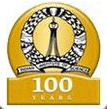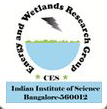 |
Assessment of Treatment capabilities of Varthur Lake, Bangalore, India |
 |
ABSTRACT
Manmade waterbodies have traditionally been used for domestic and irrigation purposes. Unplanned urbanization and ad-hoc approaches have led to these waterbodies receiving untreated sewage. This enriches and eutrophies the waterbody. A physicochemical and biological analysis of sewage-fed Varthur Lake in Bangalore was carried out and its treatment capabilities in terms of BOD removal, nutrient assimilation and self-remediation were assessed. Anaerobic conditions (0 mg/L) prevail at the inlet which improves towards the outlets due to algal aeration. This removed > 50% BOD in the monsoon season but was inhibited by floating macrophytes in all other seasons. Alkalinity, TDS, conductivity and hardness values were higher when compared to earlier studies. This study shows the lake behaves as an anaerobic~aerobic lagoon with a residence time of 4.8 d treating the wastewater to a considerable extent. Further research is required to optimise the system performance.
Keywords: Nutrients, eutrophication, lagoon, sewage, urban lakes.
Citation: Mahapatra, D.M., Chanakya, H.N. and Ramachandra, T.V. (2011) ‘Assessment of Treatment capabilities of Varthur Lake, Bangalore, India’, Int. J. Environment, Technology and Management, Vol. 14, Nos. 1/2/3/4, pp. 84-102.
Durga Madhab Mahapatra is a research scholar at Centre for Sustainable Technologies, Indian Institute of Science (IISc). His research interest includes wastewater microbiology and ecology, environmental biotechnology, environmental bioprocesses engineering, bioremediation and applied phycology.
H N Chanakya is a faculty at Centre for Sustainable Technologies and Associate Faculty at Centre for infrastructure, Sustainable Transportation and Urban Planning, Indian Institute of Science. He has been carrying out R, D & D on decentralized energy technologies (biogas plants and peripherals) and energy system integration into rural life since 1980. New design biogas plants are at different stages of field testing, demonstration and dissemination phases. Three different types of biomass based biogas plants are being disseminated - the plug-flow like biogas plants, solid-state stratified bed (SSB) biogas fermenter and biomass immobilized bioreactors for coffee and agro-processing waste waters. Details of his research and copies of publications are available at http://www.astra.iisc.ernet.in/Pages/Faculty/chanakya.html
*T V Ramachandra is a faculty at Centre for Ecological Sciences (CES) and Associate Faculty at Centre for Sustainable Technologies (astra) and Centre for infrastructure, Sustainable Transportation and Urban Planning (CiSTUP), Indian Institute of Science. His areas of research include aquatic ecosystems, ecological modeling, energy systems, environmental management, regional planning, spatial decision support systems, GIS and remote sensing. He teaches principles of remote sensing, digital image processing, environmental and natural resources management. He has published over 145 research papers as well as fourteen books. He is a fellow of the Institution of Engineers (India) and Institution of Electrical Engineers (UK), Senior member, IEEE (USA) and AEE (USA), and many similar institutions. Details of his research and copies of publications are available at http://ces.iisc.ernet.in/energy
Tel : 91-80-23600985 / 22932506 / 22933099,
Fax : 91-80-23601428 / 23600085 / 23600683 [CES-TVR]
E-mail : cestvr@ces.iisc.ernet.in, energy@ces.iisc.ernet.in, Web : http://wgbis.ces.iisc.ernet.in/energy
|